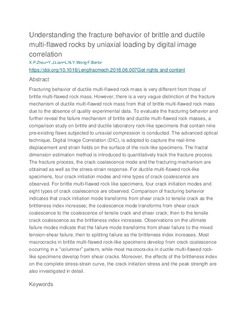| dc.contributor.author | Zhou, XP | |
| dc.contributor.author | Lian, Y.J. | |
| dc.contributor.author | Wong, L.N.Y. | |
| dc.contributor.author | Berto, Filippo | |
| dc.date.accessioned | 2019-02-25T13:50:57Z | |
| dc.date.available | 2019-02-25T13:50:57Z | |
| dc.date.created | 2018-11-26T11:51:15Z | |
| dc.date.issued | 2018 | |
| dc.identifier.citation | Engineering Fracture Mechanics. 2018, 199 438-460. | nb_NO |
| dc.identifier.issn | 0013-7944 | |
| dc.identifier.uri | http://hdl.handle.net/11250/2587275 | |
| dc.description.abstract | Fracturing behavior of ductile multi-flawed rock mass is very different from those of brittle multi-flawed rock mass. However, there is a very vague distinction of the fracture mechanism of ductile multi-flawed rock mass from that of brittle multi-flawed rock mass due to the absence of quality experimental data. To evaluate the fracturing behavior and further reveal the failure mechanism of brittle and ductile multi-flawed rock masses, a comparison study on brittle and ductile laboratory rock-like specimens that contain nine pre-existing flaws subjected to uniaxial compression is conducted. The advanced optical technique, Digital Image Correlation (DIC), is adopted to capture the real-time displacement and strain fields on the surface of the rock-like specimens. The fractal dimension estimation method is introduced to quantitatively track the fracture process. The fracture process, the crack coalescence mode and the fracturing mechanism are obtained as well as the stress-strain response. For ductile multi-flawed rock-like specimens, four crack initiation modes and nine types of crack coalescence are observed. For brittle multi-flawed rock like specimens, four crack initiation modes and eight types of crack coalescence are observed. Comparison of fracturing behavior indicates that crack initiation mode transforms from shear crack to tensile crack as the brittleness index increases; the coalescence mode transforms from shear crack coalescence to the coalescence of tensile crack and shear crack; then to the tensile crack coalescence as the brittleness index increases. Observations on the ultimate failure modes indicate that the failure mode transforms from shear failure to the mixed tension-shear failure, then to splitting failure as the brittleness index increases. Most macrocracks in brittle multi-flawed rock-like specimens develop from crack coalescence occurring in a “columnar” pattern, while most macrocracks in ductile multi-flawed rock-like specimens develop from shear cracks. Moreover, the effects of the brittleness index on the complete stress-strain curve, the crack initiation stress and the peak strength are also investigated in detail. | nb_NO |
| dc.language.iso | eng | nb_NO |
| dc.publisher | Elsevier | nb_NO |
| dc.rights | Attribution-NonCommercial-NoDerivatives 4.0 Internasjonal | * |
| dc.rights.uri | http://creativecommons.org/licenses/by-nc-nd/4.0/deed.no | * |
| dc.title | Understanding the fracture behavior of brittle and ductile multi-flawed rocks by uniaxial loading by digital image correlation | nb_NO |
| dc.type | Journal article | nb_NO |
| dc.type | Peer reviewed | nb_NO |
| dc.description.version | acceptedVersion | nb_NO |
| dc.source.pagenumber | 438-460 | nb_NO |
| dc.source.volume | 199 | nb_NO |
| dc.source.journal | Engineering Fracture Mechanics | nb_NO |
| dc.identifier.doi | 10.1016/j.engfracmech.2018.06.007 | |
| dc.identifier.cristin | 1635012 | |
| dc.description.localcode | © 2018. This is the authors’ accepted and refereed manuscript to the article. Locked until 15.6.2020 due to copyright restrictions. This manuscript version is made available under the CC-BY-NC-ND 4.0 license http://creativecommons.org/licenses/by-nc-nd/4.0/ | nb_NO |
| cristin.unitcode | 194,64,92,0 | |
| cristin.unitname | Institutt for maskinteknikk og produksjon | |
| cristin.ispublished | true | |
| cristin.fulltext | postprint | |
| cristin.fulltext | preprint | |
| cristin.qualitycode | 1 | |

